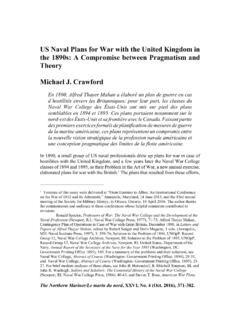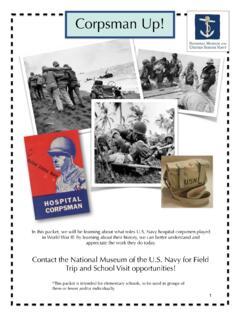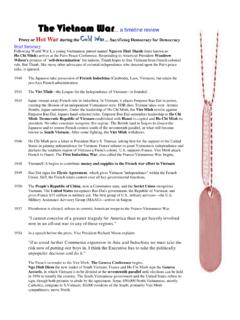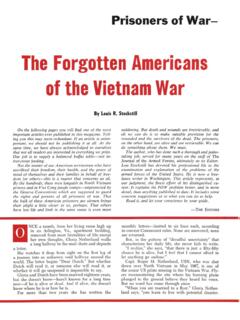Transcription of The Battle Behind Bars - NHHC
1 Stuart I. Rochester Th e B a t t l e Behind BarsNavy and Marine POWs in the vietnam WarNAVAL HISTORY & HERITAGE COMMAND | THE NAVY AND THE vietnam WARDEPARTMENT OF THE NAVYWASHINGTON, Cover: Lieutenant Commander Robert Shumaker, shown here at capture in February 1965, was the second pilot shot down over North vietnam . The Battle Behind BarsNavy and Marine POWs in the vietnam WarStuart I. RochesterThe Navy aNd The vietnam War Edward J. Marolda and Sandra J. Doyle, Series EditorsDEPARTMENT OF THE NAVYWASHINGTON, DC2010 2010 Naval Historical FoundationAll rights reserved. No portion of this book may be reproduced without written permission from the Naval Historical in the Unites States of byNaval History & Heritage Command in partnership with the Naval Historical Foundation805 Kidder Breese Street SEWashington Navy Yard, DC 20374-5060w w i stor i lBook design by Dean Gardei and Gwynn FuchsUS.
2 GOVERNMENT OFFICIAL EDITION NOTICEUse of ISBThis is the its authentiThe Superireprinted eNOfficial Government edition of this publication and is herein identified to certify city. Use of 978-0-945274-61-2 is for Government Printing Office Editions only. ntendent of Documents of the Government Printing Office requests that any dition clearly be labeled as a copy of the authentic work with a new of Congress Cataloging-in-Publication DataRochester, Stuart I., 1945 The Battle Behind bars : Navy and Marine POWs in the vietnam War / Stuart I. Rochester. p. cm. Includes bibliographical references. ISBN 978-0-945274-61-2 (alk. paper) 1. vietnam War, 1961 1975 Prisoners and prisons, American.
3 2. vietnam War, 1961 1975 Prisoners and prisons, Vietnamese. 3. United States. Navy History vietnam War, 1961 1975. 4. United States. Marine Corps History vietnam War, 1961 1975. 5. prisoners of war United States Social conditions 20th century. 6. prisoners of war United States Psychology. 7. prisoners of war vietnam Social conditions 20th century. 8. prisoners of war vietnam Psychology. I. 37 dc22 2009043826 The paper used in this publication meets the requirements for permanence established by the American National Standard for Information Sciences Permanence of Paper for Printed Library Materials (ANSI ).For sale by the Superintendent of Documents, Government Printing OfficeInternet: ; Phone: toll free 866-512-1800; DC area 202-512-1800.
4 Fax: 202-512-2104 Mail Stop: CSAPS, Washington, DC 20401 CoNTeNTSP rologue 1A Chronicle of the Captivity 5 Resistance 23 Punishment 35 Coping 45 Relief and Release 57 SidebarsMarine Captain Donald Cook 9 prisoner of War Camps in North vietnam 20 The Tap Code 27 The Most Extraordinary POW in North vietnam 30
5 Indoctrination: Torturing the Mind 40 POW Medical Care by the Enemy 52 The Author 67 Acknowledgments 67 Suggested Reading 67 This image, part of a Pentagon corridor exhibit during the vietnam War, depicts the environment of a typical Hanoi prison History Collection1 ProLoGUeIt was fitting that the senior officer aboard the first plane to land at Clark Air Base in the Philippines following the release of the American prisoners of war from Hanoi in 1973 was a naval officer. When a thin, wan Captain Jeremiah Denton descended the ramp to a bank of microphones and uttered the poignant words, We are honored to have had the opportunity to serve our country under difficult circumstances, he spoke for the entire body of comrades who over the past decade had endured the longest wartime captivity of any group of prisoners in the nation s history.
6 But no servicemen suffered through a longer, rougher captivity, or played a more prominent role in the leadership and life of the American-occupied prison camps in Southeast Asia, than the veteran Navy and Marine POWs among the Operation Homecoming returnees. They comprised a high per-centage of the early captures, dominated the ranks of the early seniors, and contributed vitally by deed and by example to the high standard of conduct and resistance that so distinguished the POWs of the vietnam War. All told, the nearly six hundred prisoners, including 25 civilians, repatriated between February and April 1973 during Operation Homecoming included 138 Navy and 26 Marine Corps personnel. Additionally, another seven Navy POWs had either escaped (two) or been released (five) earlier, and nine died in captivity.
7 Captured Marines besides the Homecoming contingent included nine who died while incarcerated, ten who escaped, two who were released prior to 1973, and one who was returned in 1979. Although only a fraction of the services POW totals of previous wars, they, along with captured members of the other services, had an influence and significance disproportionate to their small numbers, owing to their being at the center of a war waged in large part by propaganda and political persuasion in which prisoners were key pawns and bargaining chips. The Marine captives fell primarily into two categories: aviators shot down over North vietnam and held in permanent detention facilities in and around Hanoi, and younger enlistees and NCOs (noncommissioned officers), along with a handful of officers, seized by Viet Cong or North Vietnamese Army (NVA) troops in ground action in South vietnam .
8 The latter group was moved between makeshift camps mostly in the northern provinces of the South before joining the first group in the North. Because of the disparity in age and rank and related factors of training and discipline, as well as their separate geographical locations and circum-stances of confinement, the POW experiences of the two groups were distinct. Neither had an easy road, but each encountered advantages and disad-vantages relative to their situation that improved or complicated their lot. By contrast, captured Navy personnel were a homogeneous group who for the most part came from similar backgrounds and, allowing for differ-ences in dates and duration of captivity, shared a similar experience in prison.
9 Of the 138 men Navy analysts examined at Homecoming, all were officers and aviators, the majority college-educated, with an average age of 31 at time of capture and five years on average spent in confinement between 1964 and 1973. All were captured and held in North vietnam following shootdowns or accidents that required them to ditch their planes in the North. Notable exceptions among those returned to control earlier were two pilots, Lieutenant Charles Klusmann and Lieutenant (jg) Dieter Dengler, who went down in and subsequently escaped from Laos, and Seaman Douglas Hegdahl, who joined his aviator comrades in the Hanoi prison system after falling from his ship in the Gulf of Tonkin. The unconventional nature of the war and the unforgiving environment of Southeast Asia inflicted special hardships on the vietnam -era POWs, whether they spent their captivity in the 2jungles of the South or the jails of the North.
10 All were affected by the extremes of a mon-soonal climate that brought misery to captor and captive alike. Oppressively hot and humid summers that turned cells into ovens alternated with bone-chilling winters, the cold made worse by lack of adequate clothing and blankets. The absence of edible food, potable water, and medi-cine in POW encampments in the South, and their chronic scarcity in the North, caused widespread hunger, malnutrition, and disease. Compounding the harsh elements were challenges peculiar to an undeclared war that left American prisoners in a legal limbo. Characterizing the fallen aviators and captured ground personnel as air pirates and mercenaries, the enemy denied them the protection of the Geneva wartime conventions and at one point threatened to put the prisoners on trial for war crimes.



















